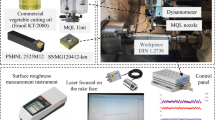Abstract
The present work is a contribution in understanding the machinability of hardened C22 steel under drilling operations using twist high-speed steel (HSS) grade drill bits. Experimental investigation has been conducted on annealed and hardened C22 steel according to the planning experience methodology (L8). The input parameters are cutting regime elements, cutting speed, feed rate, and drill diameter; meanwhile, the output parameter is the tool wear related to tool life. Apart from the common observation that tool life decreases when the cutting speed increases, the most interesting phenomenon is the controversial effect of the cutting speed when drilling the steel in hardened condition. The latter has been assessed through exploratory chip microstructure observations.
Similar content being viewed by others
References
Biermann D, Heilmann M, Kirschner M (2011) Analysis of the influence of tool geometry on surface integrity in single-lip deep hole drilling with small diameters. 1st CIRP conference on surface integrity (CSI). Procedia Eng 19:16–21. https://doi.org/10.1016/j.proeng.2011.11.074
Desargues JE, Lescalier C, Bomont-Arzur A, Bomont O (2013) High strength steel solutions for automotive parts: state of the art of machinability enhancement and further developments Tenth International Conference on High Speed Machining, Germany, 09–26—Proceedings of the Tenth International Conference on High Speed Machining—Progress in Productivity and Quality. .http://hdl.handle.net/10985/9937
Tsann-Rong L (2002) Experimental design and performance analysis of TiN-coated carbide tool in face milling stainless steel. J Mater Process Technol 127:1–7. https://doi.org/10.1016/S0924-0136(02)00026-2
Khashaba UA, El-Sonbaty IA, Selmy A, Iand A, Megahed A (2010) Machinability analysis in drilling woven GFR/epoxy composites: part II—effect of drill wear. Compos Part A 41:1130–1137. https://doi.org/10.1016/j.compositesa.2010.04.011
Bryukhanova LS, Miroshniehenko M, Polukarova ZM, Shehukin ED (1978) Optimum conditions for using molten metals in cutting solids. Effect of molten-metal chemical composition and cutting tool material on drilling of steel 45. Fiziko-Khimicheskaya Mekhanika Materialov 14(6):14–18. https://doi.org/10.1007/BF01159989
Okay S, Kaplan Y, Motorcu AR, Nalbant M (2013) Evaluation of cutting tool wear characteristics and removed chip volumes in drilling of AISI D2 and AISI D3 cold work tool steels. 7th international advanced technologies symposium (IATS’13) 30 October–1 November, Istanbul, Turkey
Kayhan M, Budak E (2009) An experimental investigation of chatter effects on tool life. P I Mech Eng B-J Eng 223:1455–1463. https://doi.org/10.1243/09544054JEM1506
Kaplan Y, Motorcu AR, Nalbant M, Okay S (2015) The effects of process parameters on acceleration amplitude in the drilling of cold work tool steels. Int J Adv Manuf Technol 80:1387–1401. https://doi.org/10.1007/s00170-015-7097-y
Lanying X, Qiang W, Mengyang Q, Yong Tang T (2016) Flank wear of twist drills and surface quality of holes in hard-to-cut materials by electric hot drilling. Int J Adv Manuf Technol 84:513–522. https://doi.org/10.1007/s00170-015-7721-y
Balaji M, Murthy BSN, Rao M (2016) Optimization of cutting parameters in drilling of AISI 304 stainless steel using Taguchi and ANOVA. Procedia Technol 25:1106–1113. https://doi.org/10.1016/j.protcy.2016.08.217
Meena A, El Mansori M (2013) Specific cutting force, tool wear and chip morphology characteristics during dry drilling of austempered ductile iron (ADI). Int J Adv Manuf Technol 69:2833–2841. https://doi.org/10.1007/s00170-013-5220-6
Abouridouane M, Klocke F, Döbbeler B (2017) Characterisation and modelling of the machinability of ferritic-pearlitic steels in drilling operations. 16th CIRP Conference on Modelling of Machining Operations. Procedia CIRP 58:79–84. https://doi.org/10.1016/j.procir.2017.03.197
Çiçek A, Kıvak T, Uygur I, Ekici E, Turgut Y (2012) Performance of cryogenically treated M35 HSS drills in drilling of austenitic stainless steels. Int J Adv Manuf Technol 60:65–73. https://doi.org/10.1007/s00170-011-3616-8
Xiangyu W, Chuanzhen H, Bin Z, Hanlian L, Wang J (2013) Effects of geometric structure of twist drill bits and cutting condition on tool life in drilling 42CrMo ultrahigh-strength steel. Int J Adv Manuf Technol 64:41–47. https://doi.org/10.1007/s00170-012-4026-2
Rodrigo P, Gerson ZL, Tiago Vacaro NT, Teixeira CR, Heiler R (2012) Implications of the reduction of cutting fluid in drilling AISI P20 steel with carbide tools. Int J Adv Manuf Technol 58:431–441. https://doi.org/10.1007/s00170-011-3401-8
Bagci E, Ozcelik B (2006) Analysis of temperature changes on the twist drill under different drilling conditions based on Taguchi method during dry drilling of Al 7075-T651. Int J Adv Manuf Technol 29:629–636. https://doi.org/10.1007/s00170-005-2569-1
Le Coz G, Jrad M, Laheurte P, Dudzinski D (2017) Analysis of local cutting edge geometry on temperature distribution and surface integrity when dry drilling of aeronautical alloys. Int J Adv Manuf Technol 93:2037–2044. https://doi.org/10.1007/s00170-017-0671-9
Acknowledgements
This work is achieved in the LRTAPM, laboratory of advanced technology in mechanical engineering of Badji Mokhtar-Annaba University, in collaboration with the LEM3, material mechanics, and microstructure studies of the University of Lorraine, Metz, France
Funding
Financial support is due to the general direction of scientific research and technological development (DGRSDT) of the Algerian ministry of higher education and scientific research (MESRS) under the CNEPRU research project LRTAPM: A11N01UN230120130011 (Annaba).
Author information
Authors and Affiliations
Corresponding author
Rights and permissions
About this article
Cite this article
Mokas, N., Boulanouar, L., Amirat, A. et al. Effect of hardening on the machinability of C22 steel under drilling operations using twist HSS drill bit. Int J Adv Manuf Technol 96, 3227–3234 (2018). https://doi.org/10.1007/s00170-018-1818-z
Received:
Accepted:
Published:
Issue Date:
DOI: https://doi.org/10.1007/s00170-018-1818-z




